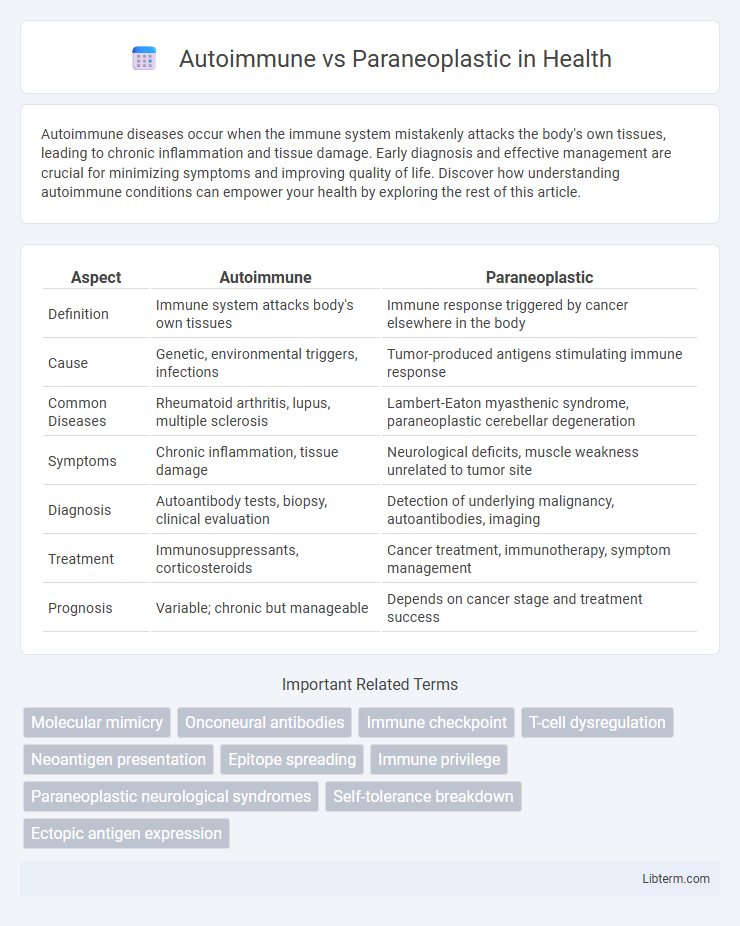Autoimmune diseases occur when the immune system mistakenly attacks the body's own tissues, leading to chronic inflammation and tissue damage. Early diagnosis and effective management are crucial for minimizing symptoms and improving quality of life. Discover how understanding autoimmune conditions can empower your health by exploring the rest of this article.
Table of Comparison
| Aspect | Autoimmune | Paraneoplastic |
|---|---|---|
| Definition | Immune system attacks body's own tissues | Immune response triggered by cancer elsewhere in the body |
| Cause | Genetic, environmental triggers, infections | Tumor-produced antigens stimulating immune response |
| Common Diseases | Rheumatoid arthritis, lupus, multiple sclerosis | Lambert-Eaton myasthenic syndrome, paraneoplastic cerebellar degeneration |
| Symptoms | Chronic inflammation, tissue damage | Neurological deficits, muscle weakness unrelated to tumor site |
| Diagnosis | Autoantibody tests, biopsy, clinical evaluation | Detection of underlying malignancy, autoantibodies, imaging |
| Treatment | Immunosuppressants, corticosteroids | Cancer treatment, immunotherapy, symptom management |
| Prognosis | Variable; chronic but manageable | Depends on cancer stage and treatment success |
Introduction to Autoimmune and Paraneoplastic Disorders
Autoimmune disorders occur when the immune system mistakenly attacks healthy tissues, leading to chronic inflammation and tissue damage, as seen in diseases like lupus and rheumatoid arthritis. Paraneoplastic disorders arise from immune responses triggered by an underlying malignancy, causing symptoms unrelated to the primary tumor but driven by onconeural antibodies or cytokines. Understanding the distinct immune mechanisms in autoimmune versus paraneoplastic processes is essential for accurate diagnosis and targeted treatment strategies.
Defining Autoimmune vs Paraneoplastic Mechanisms
Autoimmune mechanisms involve the immune system mistakenly attacking the body's own tissues due to loss of self-tolerance, often triggered by genetic predisposition and environmental factors. Paraneoplastic mechanisms arise from an immune response directed against tumor antigens that cross-react with normal tissues, causing remote tissue damage unrelated to tumor invasion. Understanding the distinction highlights autoimmune disorders as intrinsic immune dysregulation, whereas paraneoplastic syndromes represent immune-mediated effects secondary to malignancy.
Common Autoimmune Diseases Overview
Common autoimmune diseases such as rheumatoid arthritis, lupus, and multiple sclerosis involve the immune system mistakenly attacking the body's own tissues, leading to chronic inflammation and tissue damage. Paraneoplastic syndromes, in contrast, result from immune responses triggered by an underlying cancer, where antibodies or immune cells target both tumor and normal tissues. Understanding the distinct immunopathology of autoimmune diseases versus paraneoplastic syndromes is crucial for accurate diagnosis and targeted treatment approaches.
Typical Paraneoplastic Syndromes and Their Triggers
Typical paraneoplastic syndromes include Lambert-Eaton myasthenic syndrome, dermatomyositis, and paraneoplastic cerebellar degeneration, all commonly triggered by underlying malignancies such as small cell lung cancer, ovarian cancer, and Hodgkin's lymphoma. These syndromes result from immune responses elicited by tumor antigens that cross-react with normal tissues, unlike classic autoimmune diseases primarily driven by intrinsic immune dysregulation. Identification of the associated tumor is crucial for diagnosis and management, as treating the malignancy often helps alleviate paraneoplastic symptoms.
Clinical Manifestations: Autoimmune vs Paraneoplastic
Autoimmune clinical manifestations primarily involve organ-specific or systemic inflammation characterized by symptoms such as fatigue, joint pain, rash, and organ dysfunction caused by the immune system attacking self-antigens. Paraneoplastic syndrome presents with neurological symptoms including muscle weakness, sensory deficits, and cognitive changes often preceding or accompanying malignancies, driven by immune responses to tumor-associated antigens. Distinguishing features include the temporal association with cancer in paraneoplastic disorders, whereas autoimmune diseases have a broader onset unrelated to neoplasia.
Diagnostic Approaches and Key Differences
Diagnostic approaches for autoimmune disorders primarily involve serological testing for specific autoantibodies, tissue biopsies, and imaging studies to detect inflammation or organ damage. Paraneoplastic syndromes require a combination of tumor marker identification, imaging to locate underlying malignancies, and antibody panels targeting neuronal or tissue-specific antigens associated with cancer. Key differences lie in the etiology, where autoimmune diseases stem from intrinsic immune dysregulation, while paraneoplastic conditions are triggered by an immune response to neoplasms, making cancer detection crucial for accurate diagnosis and management.
Pathophysiology: Immune Response Comparison
Autoimmune diseases involve an aberrant immune response where the body mistakenly targets its own tissues through autoantibodies and autoreactive T cells, leading to chronic inflammation and tissue damage. Paraneoplastic syndromes are driven by an immune response triggered by tumor antigens, where cross-reactivity causes the immune system to attack both the tumor and normal tissues, often resulting in neurological or systemic manifestations. The key difference lies in the origin of the immune activation: intrinsic self-antigens in autoimmune conditions versus tumor-associated antigens in paraneoplastic syndromes.
Treatment Strategies for Autoimmune and Paraneoplastic Conditions
Treatment strategies for autoimmune conditions primarily involve immunosuppressive therapies such as corticosteroids, disease-modifying antirheumatic drugs (DMARDs), and biologics targeting specific immune pathways like TNF inhibitors or B-cell depleting agents. Paraneoplastic syndromes require a dual approach that includes addressing the underlying malignancy through surgery, chemotherapy, or radiation combined with immunotherapy to control immune-mediated symptoms, often utilizing corticosteroids or intravenous immunoglobulin (IVIG). Early diagnosis and tailored therapy targeting both the tumor and immune response enhance patient outcomes in paraneoplastic disorders.
Prognosis and Patient Outcomes
Autoimmune diseases often have variable prognoses depending on early diagnosis and treatment, with patient outcomes improving significantly through immunosuppressive therapies. Paraneoplastic syndromes, linked to underlying malignancies, generally indicate a more severe prognosis due to the complexity of cancer management and potential for rapid neurological decline. Early detection and targeted cancer treatment remain critical for optimizing survival rates and quality of life in patients experiencing paraneoplastic manifestations.
Future Directions in Research and Therapies
Emerging research in autoimmune and paraneoplastic disorders emphasizes the development of targeted immunotherapies leveraging advanced biomarkers and genetic profiling for personalized treatment. Novel therapeutic strategies are exploring immune checkpoint inhibitors and modulation of tumor microenvironments to distinguish and treat paraneoplastic syndromes more effectively. Future directions also include integrating machine learning algorithms to predict disease progression and optimize clinical decision-making in autoimmune and paraneoplastic conditions.
Autoimmune Infographic

 libterm.com
libterm.com